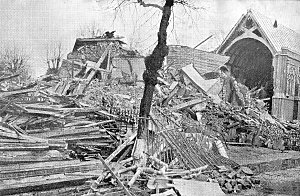
The night of 10th/11th January 1941 saw one of the heaviest air raids of World War 2 during which many important buildings were destroyed or severely damaged. High on this list were an number of ecclesiastical buildings including St. John's Cathedral, or more specifically the adjoining Bishop's House.
When the air raid sirens sounded fifteen people attached to the Cathedral and clergy house, including the three priests, proceeded to the Cathedral shelter under the Bishop's House. The three priests were the Very Rev. J. P. O'Neill, Administrator of the Cathedral, the Rev. A. Quinn, and Fr. P. O'Connor, P.S.M. The other twelve were domestic staff. Being the last to enter the shelter, Fr. O'Neill had sat next to the entrance on the same side as the majority of the occupants, while on the opposite side, next to an inside wall which was considered the safest part of the cellar, were the rest of the domestic staff.
It was early in the raid that the Bishop's House was struck by three high explosive bombs, and the whole building collapsed in a heap of ruins. The inner wall of the cellar crumbled under the shock and terrific weight, and buried the occupants on that side. The three priests and six others were saved by girders which held on one side and kept the debris off them.

Fr. O'Neill scrambled out, only to find more bombs and incendiaries falling. He reached a public shelter nearby to ask for assistance and rescuers. On learning that fourteen persons were still trapped in the cellar service men and civilians made their way to the Cathedral. One or two of the occupants were got out quickly, but after that the attempts at rescue became more difficult. A large water tank storing about two thousand gallons had been destroyed, and the water was pouring down upon the wreckage, drenching those being rescued if not endangering their lives by drowning.
The work of rescue went on for seven hours before eight persons were brought to safety. Ignoring all thought of personal danger, frantic efforts were made to reach the other six persons who were known to be buried beneath the wall which had fallen upon them, and it was not until three o'clock in the morning that hope at getting them out alive was abandoned. It was later found that the party of rescuers had been trampling over a delayed action bomb buried in the ruins.
The whole of the personal belongings of the three priests had been destroyed, and all they possessed were the clothes they were wearing at the time. All of them were drenched to the skin and Fr. O'Neill was led away by a petty officer to a nearby building which itself was in flames, and there friends provided him with a change of various articles of clothing. Shortly after daybreak Fr. Stanford, of St. Colman's, Cosham, entered the badly damaged Cathedral and rescued the Blessed Sacrament, which was removed to the Convent of the Holy Souls, Mile End.
The six who were killed were Maud Bushell, Mary and Bridget Linnane, Kitty Tribbeck, Mary Wakeford and William Woodward. They were probably buried in the mass grave for civilians at Kingston Cemetery, but it seems likely that they were all amongst the "Unidentified" bodies listed on the original memorial stone.
Tim Backhouse
March 2014
References
The archive at www.catholicherald.co.uk
The Smitten City, published by The Evening News
Memorials in Portsmouth